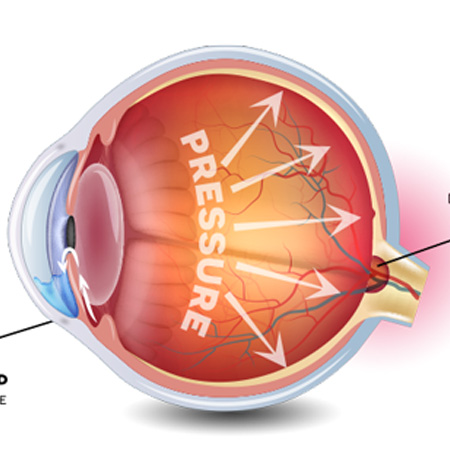



Glaucoma is a common eye condition that can lead to blindness and is the second most common cause of blindness in New Zealand. Fortunately if glaucoma is detected early and managed appropriately in nearly every case, blindness is preventable
The causes of glaucoma include:
Elevated pressure in the eye (intraocular pressure)
The principal cause of glaucoma is high pressure in the eye which damages the optic nerve and nerve fibres. This pressure comes from a build-up of a naturally produced watery fluid (aqueous fluid) in the front part of the eye that provides nutrition to the tissues inside the eye. Pressure increases when there is an imbalance between the production and drainage of the fluid.
Structure and blood supply of the optic nerve
In some patients the eye pressure is within the normal range but they still develop glaucoma due to a sensitivity of the nerve structure or its blood supply.
Family history of glaucoma
Having an immediate relative (a parent, child or sibling) with the disease significantly increases the risk. Anyone with a family history should have regular checks from the age of 40.
Age
The incidence of glaucoma increases with age. Although, it can occur in babies and young people, it is much more common in people over the age of 60.
Other conditions may increase the risk of glaucoma such as high blood pressure, diabetes and myopia (near-sightedness).
There are a number of tests that can be performed to determine whether someone has glaucoma
Tonometry
Tonometry measures the inner pressure of the eye providing an IOP (intraocular pressure) reading. Anaesthetic eye drops are used to numb the eye and then the doctor or technician uses a special device (tonometer) to measure the eye's pressure. IOP can vary from day to day and also during the day. Sometimes it is advisable to check the pressure every couple of hours from early morning until early evening to see if there are large fluctuations in a process called phasing.
Gonioscopy
Gonioscopy is a painless eye test using a contact lens that checks to see if the drainage angle of the eye is normal.
Ophthalmoscopy
Careful 3-dimensional viewing of your optic nerve reveals features which may be abnormal. These are repeated each visit looking for signs of progressive worsening.
Pachymetry
This is a simple, quick and painless test to measure the thickness of the cornea. It is important to assess this as it can have a bearing on the accuracy of eye pressure measurements.
Perimetry (visual field testing)
Computerised measurements of a patients peripheral vision are helpful to diagnose and to monitor glaucoma. During this test, the patient is asked to look straight ahead and indicate when they see a light appear in their peripheral vision. This test helps to draw a "map" of a patient's vision and any related gaps.
Nerve fibre layer measurements
The thickness of the nerve fibre layer can be measured using a non-invasive imaging technique known as Optical Coherence Tomography (OCT). Like visual field testing, this can help in diagnosing glaucoma and also monitor its progression.
Optic nerve imaging
Obtaining baseline readings of the optic nerve, and repeating the tests regularly, is important as the doctor can then see if there are any changes over time. Photos and laser scanners are used to provide this information.
Copyright ©2020 Aditya EYE Hospital || All rights reserved. Design by Sevy Inc